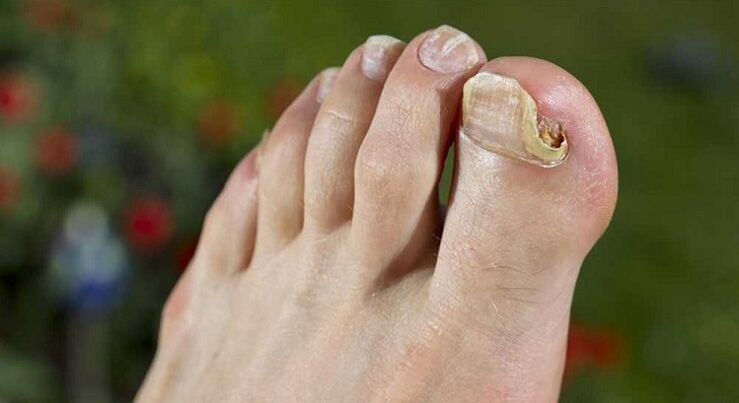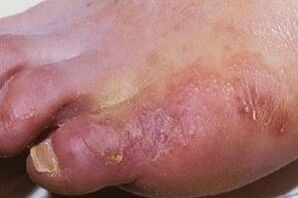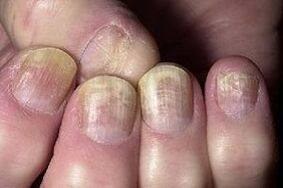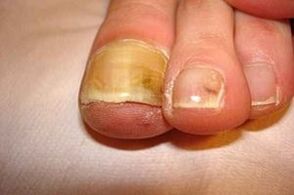Not everyone knows what toenail fungus is like, and is initially able to identify the disease and begin treatment. Itching, redness of the skin, peeling and cracking are the signs of this condition. However, there are other diseases with similar symptoms, such as eczema or psoriasis. Even toenails can change their appearance not because of a fungal infection, but because of psychological stress or a number of diseases of internal organs. So the final diagnosis can only be made by the doctor after getting the test results. And the patient’s job is to see a doctor in a timely manner if a warning sign appears.

The main symptoms of mycoses
Symptoms characteristic of mycosis of the feet are flaking, and most often of a certain shape in the form of rings or plates. Sometimes it doesn’t matter that such a situation can last for months, if not years, and at the same time not even cause much discomfort. At the same time, a number of people try to fight against such manifestations of mycosis themselves. They use folk remedies such as iodine, vinegar and brilliant greens, and for a while, the disease is completely gone. More precisely, it seems so, but in fact this treatment leads to the fact that the fungus on the feet simply freezes, and then continues to multiply when better conditions occur.
Moreover, if in the early stages of such a disease is not completely cured, but only the symptoms are eliminated, then soon it will spread to the nails and delicate skin. Not to be outdone, other family members can contract fungal diseases.

The extent of lesions in foot mycosis depends on many factors. If there are prerequisites such as microtrauma, various pathologies of the endocrine system, diabetes mellitus, if a person undergoes certain treatments with glucocorticoids or cytostatics, then all this contributes to the development of the disease.
One day the period of relative stability is over, and the patient does not see the most interesting picture - this is not only peeling on the skin, but also bubbles, weeping cracks in the legs, spray. All of these are classic symptoms found at the stage of pathological development. At the same time, the early stages of nail fungus can be seen. Although the types of microorganisms can be examined in more detail only under a microscope, their activity is more pronounced - this is the change in shape and color of the nail, then its thickening and destruction.
Fungus on nails and its manifestations
The flexibility of toenails manifests itself in different ways. It all depends on the stage of the disease and the type of fungus what is causing it. Usually, nails must be smooth, pink and even shiny. If the condition of the nail is far from the described ideal, then something is happening to the body.
Nails grow at a certain rate. When a person experiences stress, this rate decreases, and the nails become thinner and weaker. Then the body returns to normal, and the nail returns to its normal state from the point of growth indicator, but the weak strip on this nail plate still remains. And if one’s life is a bit nervous, then there may be some such lanes. In addition, onychomycosis (and this is the scientific name for nail fungus) is not the only disease that leads to discoloration of the nail plate or its shape. Pathologies such as immune failure, hormonal imbalances and other endocrine system disorders lead to similar results. That is why analysis needs to be done on a case -by -case basis.
Apparently fungi depend on microorganisms that cause onychomycosis. And can be provoked by several types. For example, if we talk about dermatophytes, then the fungus looks like a fuzzy nail. This is an early stage manifestation of toenail fungus. After that, yellow spots may appear along the edges of the plate and even in the middle. Then a longitudinal line appeared, and the nails began to crumble.
Otherwise, problems caused by yeast appear. In such cases, the nail plate becomes thinner, acquires a grayish color, and after some time has departed from its normal position. This is largely due to the fact that metabolism declines in injured cells. At the same time, the grooves that appear in the folds of the nails finally confirm the diagnosis - yeast fungus.
References should be mentioned separately. It usually only affects the nail plate, causing it to become cloudy and discolored; can be light yellow, greenish, brown and even black.
The peculiarity of these fungi is that they cause only superficial damage and do not penetrate deep inside.
It is clear that the diagnosis can only be made by the attending physician, who will consider all the symptoms and perform tests. Self -treatment without seeing a doctor is fraught with very unpleasant consequences.
Stages and types of onychomycosis

Given the degree of onychomycosis, many confuse them with this type of disease, of which there are three. It is normotrophic, hypertrophic and atrophic onychomycosis.
For example, with normotrophic onychomycosis, the color of the nail changes, lines and spots may appear on it, but its thickness and luster remain normal. Many people think that this is a nail fungus, whose initial stage will develop into a more serious pathology, but in fact the fungus in such a situation can give a good reaction to treatment.
With hypotropic onychomycosis, the color of the nail changes, its luster disappears, the nail itself thickens and deformation occurs, in some cases even destruction along the edges. Onycholytic species are often called atrophic. This is not the same toenail fungus, the initial stage is expressed in cracks and discoloration, here the treatment will be different, because of the atrophy part of the affected plate.
Treatment of foot and nail mycosis
The first thing to do with this disease is to see a doctor who will help you choose a drug that meets the following conditions:
- high antifungal activity, which allows you to fight various types of infectious agents;
- a sufficiently high concentration of the active ingredient both in the preparation itself and on the surface layer of the skin after its use;
- complex antifungal and antibacterial therapy;
- no contraindications and side effects, including allergic reactions;
- ease of use.
Given these claims, it is not surprising that the level of drug selection is very important. As a rule, if there are no complications, drugs based on substances such as ciclopirox and naftifine are used. They are produced in the form of ointments, more rarely in the form of tablets. At more serious stages of mycosis, it is recommended to treat it with drugs based on terbinafine and fluconazole.
Tablets should be taken if ointments and creams for external use have no effect. The tablet dose should be checked with the attending physician. As a rule, all these are quite strong drugs, so the treatment is around 7-10 days, although there are drugs that can be taken even for 3-4 weeks.
The treating physician prescribes such therapy, taking into account other medications that the patient will be taking. This medicine can have side effects such as vomiting or dizziness. This is considered valid. Generic drugs are lighter than natural ones, but the effects are small.
Surgical intervention
Previously, in further cases, surgery to remove the affected tissue was performed. This is especially true of nails. Now they use exercises like those used in the dental office. Even in the most advanced cases, cutting almost all nails will take about half an hour. And if the problem is only on one affected nail, then it will only take about 5 minutes.

No need to take extra precautions after the procedure. This procedure does not cause a painful sensation, you can lead a normal lifestyle, do morning jogs. It is only important to make sure the affected skin area is not injured.
A nail treatment with such a preparation is not enough, everything should be repeated at least once again, 3-4 weeks after the first treatment, when the nails grow a little. In general, you need to know the fact that this process is long, can take a month, and if everything is long enough, then several months. For example, there are cases when for the first 3-4 months the patient does nail treatment with such a tool every 2-3 weeks, and then takes the drug for several months.
Are folk remedies effective?
Any doctor would say that traditional medicine recipes for such diseases are ineffective and even dangerous. First, vinegar, herbs, and even honey, despite its antiseptic agent, practically do not affect fungi. Yes, you may have heard from a friend that some of these recipes help relieve itching or cracking. So, these symptoms are not associated with fungi. Psoriasis or similar eczema has similar symptoms and is treated with the above folk methods.
Second, these medications help eliminate the signs of the fungus, that is, they cover it up for a while, and this is enough for everyone in the family to become infected.
However, the vinegar mentioned above will be effective for other purposes - it can be used to wash bedding and shoes to prevent bacterial infections on recurrence. The only shoes that are not washed but discarded are house slippers, as they cannot be disinfected. Vinegar can also be used to disinfect bathtubs.





























